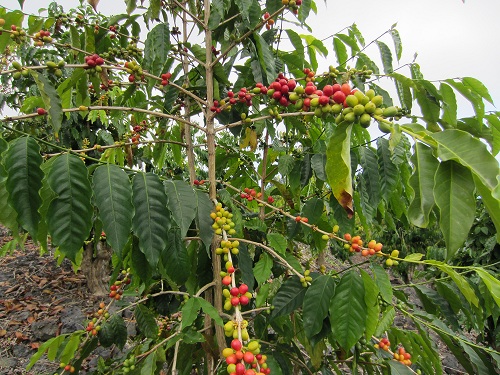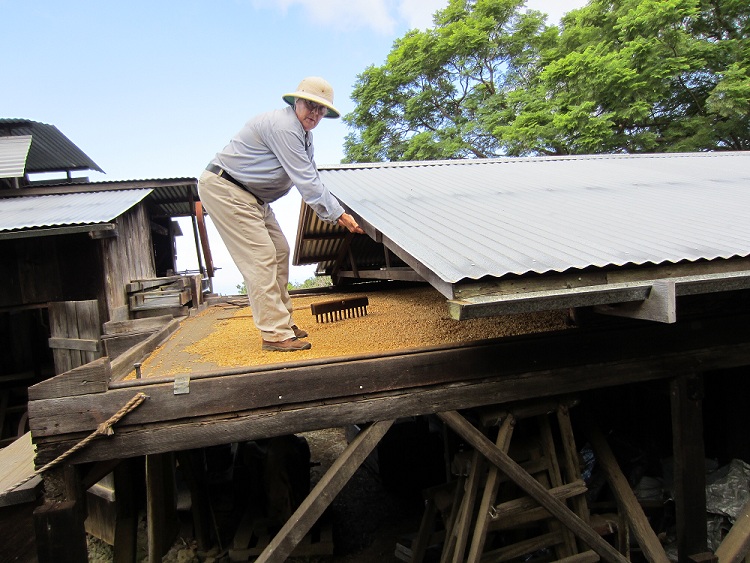Returning to My Roots: A Visit to a Living History Kona Coffee Farm
 Monday, August 22, 2011 at 4:00AM
Monday, August 22, 2011 at 4:00AM  Cooking rice over a wood stoveBy Sandy Hu
Cooking rice over a wood stoveBy Sandy Hu
Last week, I stepped back in time and into my childhood at The Kona Coffee Living History Farm in Captain Cook, Kona, on the Big Island of Hawaii. This living museum chronicles the life of immigrant Japanese coffee farmers from 1926 to 1945 through the original farmhouse and seven-acre coffee farm of the Uchida family. Their life mirrored that of my grandparents, Iwaki and Kitsu Honda, and their nine children.
While the farm is historically accurate to 1945, so much of that lifestyle continued well past it, to my own childhood, when, living in Hilo on the other side of the island, we would visit my grandparents, aunts and uncles, all coffee farmers at the time. As kids, we picked our share of coffee, too, during peak coffee season.
Kona coffee, prized the world over today, is an industry that was built on the backs of immigrant farmers on small family farms of five to ten acres. Coffee was first introduced to Kona in 1828 by an American missionary. By 1900, Japanese immigrants were the largest ethnic group farming coffee. Having arrived in Hawaii as contract laborers for the sugar plantations, these immigrants found that starting small coffee farms gave them a measure of economic autonomy.
The families were resourceful and hard-working, as a visit the farm demonstrates. Some things you will see:
On the land:
 Kona coffee ripening on the treeThe coffee fields where you can see Kona coffee growing.
Kona coffee ripening on the treeThe coffee fields where you can see Kona coffee growing.- The kitchen garden where farm families grew food to for the table – ginger, green onions, Japanese eggplant and more.
- The family donkey, called the Kona Nightingale because of its loud braying, used to transport 100-pound burlap bags full of coffee to the mill.
- The original free-range chickens raised for their eggs and destined for the stew pot in their old age.
- Coffee-picking equipment: baskets to strap around the waist, woven from bamboo or lauhala fronds and reinforced with rubber strips from spent tires.
- Shoes made with tire rubber soles and tops fashioned from pants legs of denim jeans – the Japanese farmers were short and extra fabric cut off the hems of their jeans were used to make these shoes.
- Tin cans to hang around the necks of the tiniest children, used to enable little ones to pick the lower branches of coffee, or to pick up coffee from the ground.
- Ladders held together in the center with hooks and eyes instead of hinges so the legs can find purchase on the rocky ground.
- In the farmhouse:
- Woodstove heated by burning pruned coffee branches.
- Aprons and dish towels made from rice bags.
- Water filter (the source of water was from water tanks on the property) made by tying a Bull Durham tobacco pouch over the mouth of the faucet.
- Wooden tub to pickle vegetables in brine, called tsukemono or koko, a staple of the Japanese diet.
- A cabinet with a mesh front to enable air to flow through; a place to store perishable foods.
- Sardine cans at the base of table legs, filled with oil to prevent bugs from crawling up to the food.
In the outer buildings:
 Coffee drying platformJapanese furo – a wooden bathtub, with water heated by burning coffee branches at the base of the tub.
Coffee drying platformJapanese furo – a wooden bathtub, with water heated by burning coffee branches at the base of the tub.- Coffee pulping machine and coffee washing area where beans were soaked to ferment overnight.
- Coffee drying platform to dry the pulped coffee, with a rolling roof that could be pulled over the drying coffee to protect it in time of rain. The dried coffee (parchment) commanded a higher price than the fresh cherries (beans) and could be stored longer.
- Outhouse.
- Laundry room.
- Water tank – the only source of water.
Knowledgeable interpreters of the living history farm engage guests with historically accurate demonstrations, bringing the period to life.
Here’s a recipe that would fit right into that time period. It was developed by my mother, Kiyome or Kay, and given to me by my Aunty Fujie in Hilo yesterday.
Kay’s Koko
This is an easy Japanese pickle. It would be served as an accompaniment to any Japanese meal and drizzled with a little soy sauce.
2 medium cabbages, quartered, core trimmed to ½-inch and cabbage cut crosswise in 1-inch pieces
1/3 cup sugar
1/3 cup Hawaiian salt (coarse sea salt)
1/3 cup Japanese rice wine vinegar
Put cabbage in a deep pot, pour boiling water over to cover, let sit for a minute or two, and drain cabbage in a colander.
Combine sugar, salt, vinegar and 6 cups water; bring to a boil, remove from heat and let stand at room temperature until warm. Put cabbage and liquid mixture into a glass gallon jar and let stand at room temperature for 1 day before eating. Refrigerate remainder. Makes about 2 quarts.
Special Fork is a recipe website for your smartphone and PC that solves the daily dinnertime dilemma: what to cook now! Our bloggers blog Monday through Friday to give you cooking inspiration. Check out our recipe database for quick ideas that take no more than 30 minutes of prep time. Join the conversation on Facebook and follow us on Twitter.
Reader Comments (3)
Sandy, I loved your post. I am not a coffee drinker, but I thoroughly enjoying reading about the history of coffee on the island of Hawaii. I found it fascinating.
I’m so glad you liked my Kona coffee story. It’s wonderful that the Kona Historical Society has preserved this authentic coffee farm to recapture the period and the people for all time. For those of us who have roots in coffee farming, it’s a meaningful way to remember the issei (first generation Japanese immigrants).
-Sandy
We were delighted, enthralled, and engaged (including 5 grandchildren!) by outstanding interpreters who exhibited passion and deep knowledge of this beautifully resourceful and simplistic way of living. We have strong ties to the Japanese culture and country through our children and grandchildren brought in via marriage. Deepest gratitude to the historical society and staff for telling this invaluable story and preserving this special place- may in continue on in perpetuity!